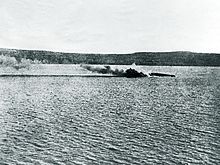French battleship Bouvet

| |
| Warship | |
|---|---|
| Shipyard: | Lorient, France
Constructor: Charles Ernest Huin |
| Laid down: | January 16, 1893 |
| Launched: | April 27, 1896 |
| Commissioned: | June 1898 |
| Fate: | Sunk by mine, March 18, 1915 |
| General Characteristics | |
| Displacement: | 12,007 tons |
| Length: | 117.81 m |
| Beam: | 21.39 m |
| Draft: | 8.38 m |
| Propulsion: | |
| Speed: | 18 knots (33 km/h) |
| Complement: | 666 to 710 |
| Armament: | • 2 × 12 in (305 mm) 45-calibre guns • 2 × 10.8 in (274 mm)/45-cal guns • 8 × 5.5 in (140 mm) 45-cal guns • 8 × 3.9 in (99 mm) guns • 12 × 3 pounder (1.4 kg) guns • 2 × 18 in (457 mm) torpedo tubes |
The French battleship Bouvet was a pre-Dreadnought battleship of the French Navy, launched in 1896 and sunk by mine in 1915 during World War I. She was the fifth of the Charles Martel class of battleships. Bouvet had face-hardened armour above the waterline, making her one of the most powerfully protected warships of her era. It was named for the maritime family of Bouvet de Lozier, the most famous being French admiral François Joseph Bouvet.
The Bouvet was part of the squadron contributed by the French to the Dardanelles Campaign. On March 18, 1915, the British commander, Rear Admiral John de Robeck, launched a concerted effort to overwhelm the Turkish forts defending the Dardanelles straits and the Bouvet was one of the four French battleships making up the second line.

Bouvet sustained eight hits from Turkish artillery fire and the forward turret was disabled. When de Robeck ordered the French line to retire, Bouvet turned to starboard into Erin Keui Bay where a line of mines lay undetected. The battleship struck a mine below the starboard 10.8-in turret and suffered a massive explosion, probably of a magazine. Flooding was rapid since the ship lacked effective internal compartmentation (the detonation occurred in a very large machinery space that extended almost a third of the length of the vessel). The ship heeled very rapidly, since the hull was designed (like many French battleships designed by Huin) with a "tumblehome" form, meaning the sides sloped inwards; this meant that the hull was losing stability for every degree that it heeled over, which sped up the process of capsizing. Bouvet capsized and sank within two minutes, taking over 600 crew with her.
Despite the loss of the Bouvet, the first such loss of the day, the British remained unaware of the minefield, thinking the explosion had been caused by a shell or torpedo. Subsequently two British battleships, the Ocean and Irresistible, were sunk and the battlecruiser HMS Inflexible, as well as the battleships Suffren and Gaulois, were damaged by the same minefield.
"Gaulois", also with a tumblehome hull form, was later repaired and fitted with large caissons at the sides to prevent the same kind of disaster that befell "Bouvet". When Gaulois was torpedoed in 1916, the caissons kept the ship upright long enough for the majority of the crew to evacuate.
The disaster of "Bouvet" was a major factor in the decision to abandon a naval strategy to take Constantinople, and instead opt for the Gallipoli land campaign.
See French ship Bouvet for other ships of this name.
